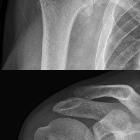erosive Arthrose










Erosive (inflammatory) osteoarthritis is a form of hand osteoarthritis (OA) where, as the name implies, there is an additional erosive/inflammatory component.
Epidemiology
There is marked female predilection (F:M ~12:1), typically presenting in the postmenopausal patient.
Clinical presentation
Clinically the presentation mimics inflammatory arthropathies such as psoriatic arthritis (PsA) or rheumatoid arthritis (RA). Patients complain of a relatively acute or subacute onset of morning stiffness in the fingers of both hands. Systemic symptoms, however, are absent.
Pathology
Erosive osteoarthritis exhibits a combination of degenerative cartilage changes as well as a rheumatoid arthritis-like proliferative synovitis . Erosive osteoarthritis is a subset of non-erosive OA, rather than a disease in its own right .
Markers
- rheumatoid factor: negative
- antinuclear antibody (ANA): negative
- ESR/CRP: negative or slightly elevated
Radiographic features
Plain radiograph
Erosive osteoarthritis has a predilection for the hands. The dominant features are those of osteoarthritis, particularly in terms of distribution:
- distal interphalangeal (DIP) joints
- proximal interphalangeal (PIP) joints
- first carpometacarpal (CMC) joint
Additional characteristic features include:
- diffuse cartilage loss, with joint space narrowing
- subchondral erosions (at least two central erosions affecting separate interphalangeal joints); typical central location of the erosions produces the classic "gull-wing" appearance
- joint ankylosis
- absence of
- marginal erosions
- fusiform soft-tissue swelling
- osteopenia
Treatment and prognosis
Treatment is conservative unless the disease advances to joint destruction and/or contractures, which may require surgical arthrodesis, arthroplasty, or tendon repair.
The prognosis is good with remission after several years being seen in most patients. The degenerative changes of course remain and are then merely those of osteoarthritis.
Differential diagnosis
Imaging differential considerations include:
- non-erosive osteoarthritis: same distribution and degenerative changes, but without erosions
- rheumatoid arthritis: different joint distribution, proximal joints in rheumatoid arthritis
- psoriatic arthritis
- usually does not involve the first carpometacarpal joint, scaphotrapezoid, and scaphotrapezium joints, which are typical for osteoarthritis
- for a wider differential list, refer to differential diagnosis of erosive arthritis
Siehe auch:
und weiter:

 Assoziationen und Differentialdiagnosen zu erosive Arthrose:
Assoziationen und Differentialdiagnosen zu erosive Arthrose:


